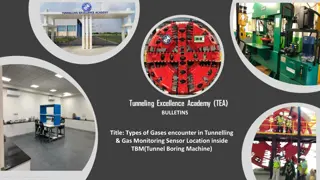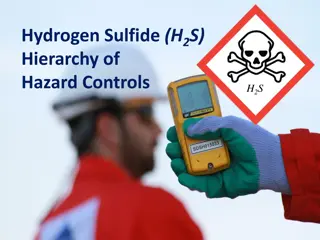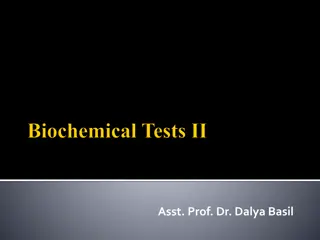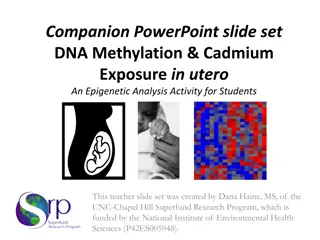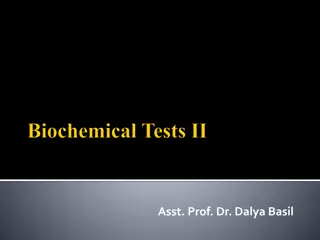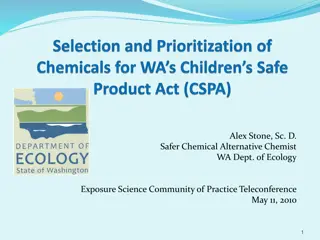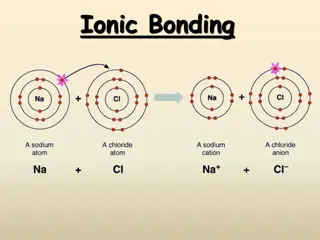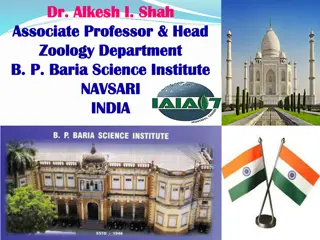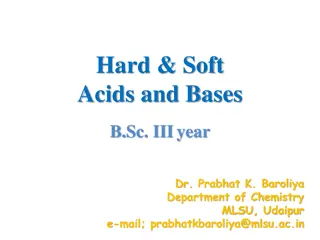Types of Gases in Tunnelling & Gas Monitoring Sensors in TBM
Understanding the types of gases encountered in tunnelling is crucial for safety. Gases like carbon monoxide, carbon dioxide, nitrogen oxides, methane, and hydrogen sulfide are common in TBM environments. Proper gas monitoring sensor placement inside the TBM is essential to detect hazardous gas leve
0 views • 11 slides
Understanding Hydrogen Sulfide (H2S) Hazard Controls in Industrial Operations
Explore the systematic approach and workplace practices for managing H2S risks, including control measures, potential problem areas, well control procedures, and common types of hazard controls like engineering controls, administrative controls, and personal protective equipment.
0 views • 13 slides
Understanding the Basics of Solar Cells: Types, Materials, and Working Principles
Solar cells, also known as photovoltaic devices, convert light energy into electrical energy through the photovoltaic effect. They consist of different generations with varying materials such as crystalline silicon, cadmium telluride, and gallium arsenide. Learn about the construction, working princ
8 views • 32 slides
Chemistry Concepts: Valence Electrons, Ion Charges, and Ionic Compounds
Explore various key concepts in chemistry such as valence electrons in magnesium, Lewis Dot structure for silicon, charges on ions like strontium, formation of ions to achieve noble-gas electron configuration, elements forming ions with specific charges, and the octet rule. Learn about the character
1 views • 48 slides
Understanding Triple Sugar Iron Agar (TSI Agar) Test
Triple Sugar Iron Agar (TSI Agar) is a differential media used for identifying gram-negative enteric bacilli based on carbohydrate fermentation and hydrogen sulfide production. It helps detect carbohydrate fermentation, gas production, acidification, and H2S formation, providing valuable information
1 views • 28 slides
Understanding the Triple Sugar Iron Test in Biochemical Analysis
The Triple Sugar Iron Test (TSI) is a crucial biochemical test used to differentiate gram-negative enteric bacilli based on their carbohydrate fermentation and hydrogen sulfide production. By examining color changes, gas production, and precipitate formation, microbiologists can interpret TSI result
2 views • 31 slides
Light Tracking Servo System Using Cadmium Sulfide Resistors
Introduction to an Arduino-based light tracking system using Cadmium Sulfide light-dependent resistors. The system tracks the maximum light intensity and automatically adjusts its direction towards the brightest source. It includes an Arduino-based Lux Meter and specifications such as DAC resolution
0 views • 7 slides
Understanding DNA Methylation and Cadmium Exposure in Utero: An Epigenetic Analysis
Explore the complex relationship between DNA methylation and in utero exposure to cadmium through a set of informative slides created by Dana Haine, MS. Learn about the impacts of DNA methylation on gene expression and how changes in methylation levels can lead to gene silencing or activation. Disco
0 views • 8 slides
Understanding Triple Sugar Iron Agar (TSI Agar) Test in Microbiology
Gain insights into the Triple Sugar Iron Agar (TSI Agar) test used for differentiating gram-negative enteric bacilli based on carbohydrate fermentation and hydrogen sulfide production. Learn about detecting carbohydrate fermentation, interpreting results, and performing the test accurately with deta
0 views • 28 slides
Understanding Percentage Composition in Chemistry
Percentage composition is crucial in determining the elemental composition of compounds. This lesson explains how to calculate percentage composition using molar masses, illustrated with examples like copper sulfide. It also delves into hydrated salts and their significance in chemistry. Students wi
0 views • 22 slides
Regulation of Chemicals in Children's Products for Safety
Massive safety concerns arose in 2007 due to high lead levels in toys, leading to legislation like the Children's Safe Product Act in WA. The Act restricted lead, cadmium, and phthalates in children's products, with a focus on Chemicals of High Concern to Children (CHCCs). The implementation involve
0 views • 27 slides
Understanding Ionic Bonding and Octet Rule in Chemistry
Understanding the concept of ionic bonding and octet rule in chemistry is essential for grasping how atoms combine to form molecules through sharing or exchanging electrons. This process involves the formation of positive and negative ions held together by electrostatic attraction, leading to the cr
0 views • 12 slides
Protecting Wild Rice in Minnesota: Sulfate Standards and Environmental Preservation
Understanding the importance of safeguarding wild rice in Minnesota due to its cultural, spiritual, and economic significance along with its sensitivity to sulfate pollution. Exploring sources of sulfate, the sulfate-sulfide relationship, and proposed solutions for maintaining wild rice populations.
0 views • 10 slides
Additional Public Health Considerations on Horne Smelter: Expert Analysis
The presentation addresses public health concerns post the publication of the Carcinogenic Risk Assessment in Rouyn-Noranda, focusing on arsenic, lead, and cadmium exposure risks with proposed reference values. It delves into non-carcinogenic effects, risk projections, and methodology used for evalu
1 views • 23 slides
All About Chalcopyrite: A Shiny Metallic Mineral
Shiny and metallic, chalcopyrite is a mineral that comes in various colors, with a brass-yellow appearance and often an iridescent tarnish. Forming in igneous and metamorphic rocks, it is commonly found alongside other copper sulfide minerals. Chalcopyrite is a primary ore mined for copper, known fo
0 views • 7 slides
EU-Serbia-Romania Cross-border Cooperation on Ecologic Filler Alloys for Soldering
This project, funded by the European Union Structural Funds 2007-2013, involves a collaboration between the Serbian and Romanian governments to develop new ecologic filler alloys for soldering. The initiative aims to promote the use of non-ferrous ores from the Romanian-Serbian cross-border area to
0 views • 10 slides
Understanding Heavy Metal Toxicity: Impacts on Aquatic Life and Human Health
Heavy metal toxicity poses a significant threat to both aquatic ecosystems and human health, with various heavy metals accumulating in the environment and food chain. This overview highlights the adverse effects of heavy metals like copper, nickel, zinc, cobalt, and cadmium on physiological processe
0 views • 39 slides
Understanding Hard & Soft Acids and Bases in Chemistry
Explore the concepts of hard and soft acids and bases in chemistry, including the Arrhenius, Brønsted-Lowry, Lewis, and Solvent System models. Learn about the HSAB principle introduced by R.G. Pearson, discussing polarizing power and polarizability of acids and bases. Understand how these principle
0 views • 15 slides
